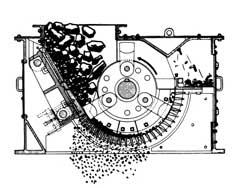Difference between revisions of "Attrition Crushers"
Jump to navigation
Jump to search
| Line 11: | Line 11: | ||
Attrition is a term applied to the reduction of materials by scrubbing it between two hard surfaces. Reducing it in size and shape. Used with friable or not too abrasive materials. Hammermills operate with close clearances between the hammers and the screen bars, and they reduce by attrition combined with shear and impact reduction. Though attrition consumes more power and increases wear on hammers and screen bars, it is practical for crushing less abrasive materials such as pure limestone and coal. | '''Attrition''' is a term applied to the reduction of materials by scrubbing it between two hard surfaces. Reducing it in size and shape. Used with friable or not too abrasive materials. Hammermills operate with close clearances between the hammers and the screen bars, and they reduce by attrition combined with shear and impact reduction. Though attrition consumes more power and increases wear on hammers and screen bars, it is practical for crushing less abrasive materials such as pure limestone and coal. | ||
Revision as of 04:34, 3 February 2012
Attrition is a term applied to the reduction of materials by scrubbing it between two hard surfaces. Reducing it in size and shape. Used with friable or not too abrasive materials. Hammermills operate with close clearances between the hammers and the screen bars, and they reduce by attrition combined with shear and impact reduction. Though attrition consumes more power and increases wear on hammers and screen bars, it is practical for crushing less abrasive materials such as pure limestone and coal.
